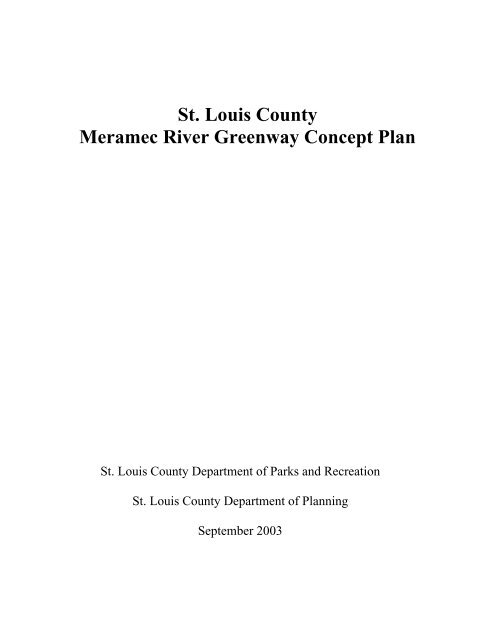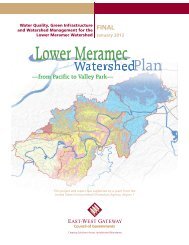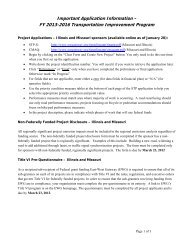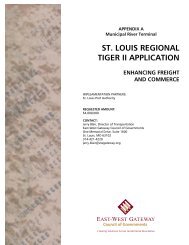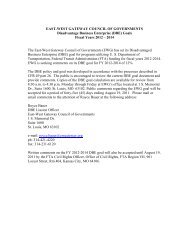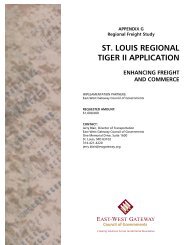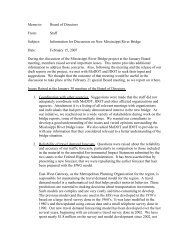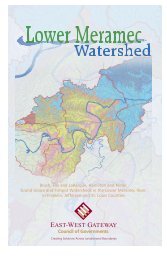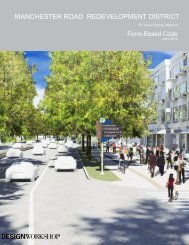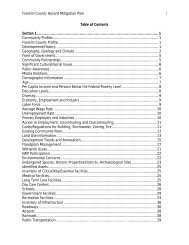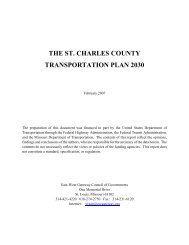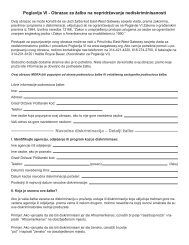St. Louis County Meramec River Greenway Concept Plan, 2003
St. Louis County Meramec River Greenway Concept Plan, 2003
St. Louis County Meramec River Greenway Concept Plan, 2003
Create successful ePaper yourself
Turn your PDF publications into a flip-book with our unique Google optimized e-Paper software.
<strong>St</strong>. <strong>Louis</strong> <strong>County</strong><br />
<strong>Meramec</strong> <strong>River</strong> <strong>Greenway</strong> <strong>Concept</strong> <strong>Plan</strong><br />
<strong>St</strong>. <strong>Louis</strong> <strong>County</strong> Department of Parks and Recreation<br />
<strong>St</strong>. <strong>Louis</strong> <strong>County</strong> Department of <strong>Plan</strong>ning<br />
September <strong>2003</strong>
<strong>County</strong> Council<br />
<strong>Plan</strong>ning Commission<br />
Project <strong>St</strong>aff<br />
George R. “Buzz” Westfall<br />
<strong>County</strong> Executive<br />
Genie Zakrzewski, Director of Parks and Recreation<br />
Glenn A. Powers, Director of <strong>Plan</strong>ning<br />
Gregory F. Quinn, Seventh District, Chairman<br />
John Campisi, Sixth District, Vice Chairman<br />
Charlie A. Dooley, First District<br />
Kathleen Burkett, Second District<br />
Skip Mange, Third District<br />
Michael O’Mara, Fourth District<br />
Kurt S. Odenwald, Fifth District<br />
Douglas Morgan, Chairman<br />
Kenneth Otto, Vice-Chairman<br />
Maureen Ramshaw, Secretary<br />
William Ballard<br />
James Hayes<br />
Wayne Hilzinger<br />
Patricia Ottoline<br />
Arnold Crutchfield<br />
Susan Polling, Department of Parks and Recreation<br />
Ben Knox, Department of Parks and Recreation<br />
Carolyn Nolan, Department of <strong>Plan</strong>ning<br />
Andrew Gulotta, Department of <strong>Plan</strong>ning<br />
Joanne Gladney, Department of <strong>Plan</strong>ning<br />
Cover design: Gladys Lewis, Department of Parks and Recreation
Contents<br />
I. Purpose of This Document.............................................................................................1<br />
II. Background of the <strong>Meramec</strong> <strong>Greenway</strong> <strong>Concept</strong>..........................................................2<br />
A. Major <strong>St</strong>udies Supporting the <strong>Meramec</strong> <strong>Greenway</strong>.................................................2<br />
B. Chronology of Events Supporting and Demonstrating Public Support for the<br />
<strong>Meramec</strong> <strong>Greenway</strong>.................................................................................................5<br />
III. Goals/Purposes to be Achieved by the <strong>Meramec</strong> <strong>Greenway</strong>.........................................8<br />
Goal: Protection of the Environment ............................................................................8<br />
Goal: Reclamation of the Natural <strong>St</strong>ate of the <strong>River</strong> ....................................................9<br />
Goal: Interconnectivity of Natural, Recreational and Cultural Sites ..........................10<br />
Goal: Expanded Recreational Opportunities and Facilities........................................10<br />
Goal: Natural Resources and Environmental <strong>St</strong>ewardship Education........................11<br />
Goal: Enhancement of Quality of Life and Regional Economic<br />
Competitiveness............................................................................................12<br />
IV. Geographic Extent: Definition of the <strong>Greenway</strong> ........................................................12<br />
V. The <strong>Meramec</strong> <strong>Greenway</strong> Master <strong>Plan</strong>..........................................................................13<br />
VI. Public Support..............................................................................................................14<br />
VII. Implementation ............................................................................................................16<br />
A. Public/Private Partnership......................................................................................16<br />
B. <strong>Meramec</strong> <strong>River</strong> Recreation Association ................................................................16<br />
C. Great <strong>River</strong>s <strong>Greenway</strong>..........................................................................................16<br />
D. <strong>St</strong>. <strong>Louis</strong> <strong>County</strong> ....................................................................................................17<br />
E. Jefferson <strong>County</strong> and Franklin <strong>County</strong>..................................................................18<br />
F. Municipalities: Sunset Hills, Kirkwood, Fenton, Valley Park, Wildwood,<br />
Eureka and Pacific in <strong>St</strong>. <strong>Louis</strong> <strong>County</strong> and Arnold in Jefferson <strong>County</strong> .............19<br />
G. Missouri Department of Natural Resources and Missouri Department of<br />
Conservation ..........................................................................................................19<br />
H. H. Private Institutions and Private Property Owners............................................19<br />
VIII. Conclusion ...................................................................................................................20<br />
Map: <strong>Meramec</strong> <strong>Greenway</strong> <strong>2003</strong>.........................................................................................21<br />
Map: <strong>Meramec</strong> <strong>Greenway</strong> <strong>Concept</strong> <strong>Plan</strong>...........................................................................22
<strong>St</strong>. <strong>Louis</strong> <strong>County</strong><br />
<strong>Meramec</strong> <strong>River</strong> <strong>Greenway</strong><br />
<strong>Concept</strong> <strong>Plan</strong>:<br />
A <strong>St</strong>. <strong>Louis</strong> <strong>County</strong> General <strong>Plan</strong> Document<br />
I. Purpose of This Document<br />
The <strong>Meramec</strong> <strong>River</strong> <strong>Greenway</strong> has been a central concept of park and recreation<br />
planning in <strong>St</strong>. <strong>Louis</strong> <strong>County</strong> for nearly three decades. The <strong>Meramec</strong> <strong>Greenway</strong> concept<br />
has been endorsed in several planning documents over the years, and Master <strong>Plan</strong><br />
documents relating to portions of the <strong>Meramec</strong> <strong>Greenway</strong> have been developed and<br />
adopted by the <strong>St</strong>. <strong>Louis</strong> <strong>County</strong> Council.<br />
When the Metropolitan Park and Recreation District, now known as the Great<br />
<strong>River</strong>s <strong>Greenway</strong>s, was created in 2000 with the approval of a one tenth of one cent sales<br />
tax to support parks and recreation development, new resources became available to<br />
implement the long-standing goal of the <strong>St</strong>. <strong>Louis</strong> <strong>County</strong> Parks Department, the<br />
<strong>Meramec</strong> <strong>River</strong> Recreation Association and cooperating municipalities and private<br />
groups.<br />
This endorsement of the <strong>St</strong>. <strong>Louis</strong> <strong>County</strong> <strong>Meramec</strong> <strong>River</strong> <strong>Greenway</strong> is intended<br />
to officially incorporate into the <strong>County</strong>’s General <strong>Plan</strong> the high priority goals of<br />
preservation and reclamation of the <strong>Meramec</strong> <strong>River</strong> for its aesthetic, environmental,<br />
educational, recreational and economic values and benefits to the <strong>St</strong>. <strong>Louis</strong> metropolitan<br />
area and <strong>St</strong>. <strong>Louis</strong> <strong>County</strong> in particular. This document aims to clarify the full extent of<br />
the vision for the <strong>Meramec</strong> <strong>Greenway</strong> and <strong>St</strong>. <strong>Louis</strong> <strong>County</strong>’s commitment to that vision.<br />
Incorporation of the <strong>Meramec</strong> <strong>Greenway</strong> concept into <strong>St</strong>. <strong>Louis</strong> <strong>County</strong>’s General <strong>Plan</strong> is<br />
intended as a recognition of the <strong>Meramec</strong> <strong>Greenway</strong>’s significance in past and future land<br />
use, environmental and recreational planning and to effectuate implementation strategies<br />
that will facilitate the fulfillment of the <strong>Meramec</strong> <strong>Greenway</strong> <strong>Plan</strong>.<br />
The endorsement document is not a new plan. Rather, it is a summary of a the<br />
history of a thirty-eight year old concept and twenty-eight years of planning by the <strong>St</strong>.<br />
<strong>Louis</strong> <strong>County</strong> Department of Parks and Recreation in collaboration with the <strong>Meramec</strong><br />
<strong>River</strong> Recreation Association and participating public, semi-public and private entities<br />
for the furtherance of the goals of the <strong>Meramec</strong> <strong>Greenway</strong>.<br />
1
II. Background of the <strong>Meramec</strong> <strong>Greenway</strong><br />
<strong>Concept</strong><br />
The scenic and recreational values of the Lower <strong>Meramec</strong> <strong>River</strong> valley were<br />
recognized in the early 1900’s, when the Missouri Pacific and Frisco railroad lines<br />
provided <strong>St</strong>. <strong>Louis</strong>ans with easy access to <strong>Meramec</strong> <strong>River</strong> beaches at Valley Park and<br />
Times Beach. The river valley became a popular destination for swimming, fishing,<br />
canoeing, hiking and weekending in the “clubhouse” or resort cottage communities along<br />
the river. The accessibility from <strong>St</strong>. <strong>Louis</strong> and the inexpensive recreational opportunities<br />
made the <strong>Meramec</strong> <strong>River</strong> in <strong>St</strong>. <strong>Louis</strong> <strong>County</strong> very popular in the 1920’s and earlier.<br />
Recreational facilities along the <strong>Meramec</strong> and the river itself suffered in<br />
subsequent years. The Great Depression of the 1930’s and repeated flooding contributed<br />
to the deterioration of recreation facilities, while encroaching urbanization with the<br />
disposal of untreated sewage into the river degraded water quality. Sand and gravel<br />
extraction altered the natural flow of the river. <strong>St</strong>retches of the riverbank suffered from<br />
erosion where trees had been removed for construction of cottages, and illegal dumping<br />
and the accumulated debris from flood-damaged properties added to the degradation of<br />
the river and its banks.<br />
A. Major <strong>St</strong>udies Supporting the <strong>Meramec</strong> <strong>Greenway</strong><br />
Since 1965 – for almost four decades – a <strong>Meramec</strong> <strong>Greenway</strong> has been<br />
contemplated as a major recreational and scenic asset for <strong>St</strong>. <strong>Louis</strong> <strong>County</strong> and the <strong>St</strong>.<br />
<strong>Louis</strong> metropolitan region. The following is a summary of major planning studies that<br />
have promoted the concept of a <strong>Meramec</strong> <strong>River</strong> <strong>Greenway</strong> in <strong>St</strong>. <strong>Louis</strong> <strong>County</strong> and<br />
adjacent counties and major events in the effort to realize the goal of a continuous<br />
greenway along the <strong>Meramec</strong> <strong>River</strong>:<br />
The Challenge of Growth: A <strong>St</strong>udy of Major <strong>County</strong> and Regional Park Needs, <strong>St</strong>.<br />
<strong>Louis</strong> <strong>County</strong> <strong>Plan</strong>ning Commission, July 1965.<br />
The Challenge of Growth was an urgent call for a major program of land<br />
acquisition for public recreational areas. Citing a tremendous increase in attendance at<br />
<strong>St</strong>ate and <strong>County</strong> parks in <strong>St</strong>. <strong>Louis</strong> <strong>County</strong>, the report proposed twenty-four major<br />
<strong>County</strong> park sites, including several that have since been acquired and developed as<br />
<strong>County</strong> parks: Queeny Park, Bee Tree Park, Cliff Cave Park and expansions of other<br />
<strong>County</strong> Parks. This document also proposed a Lower <strong>Meramec</strong> <strong>River</strong> Regional Park,<br />
extending the full length of the <strong>Meramec</strong> <strong>River</strong> in <strong>St</strong>. <strong>Louis</strong> <strong>County</strong> from its mouth to the<br />
western border of the <strong>County</strong> at Pacific. The proposed park would be planned as a<br />
unified 10,000-acre greenbelt.<br />
A Proposal for a National Recreation Area on the Lower <strong>Meramec</strong> <strong>River</strong>, <strong>St</strong>. <strong>Louis</strong><br />
<strong>County</strong> Department of <strong>Plan</strong>ning and Jefferson <strong>County</strong> <strong>Plan</strong>ning and Zoning Commission,<br />
August 1967.<br />
2
The goal of reclaiming the natural beauty of the <strong>Meramec</strong> <strong>River</strong> and developing<br />
its enormous potential for providing recreational opportunities for the <strong>St</strong>. <strong>Louis</strong><br />
community and even for a national constituency was embodied in a joint proposal by the<br />
<strong>St</strong>. <strong>Louis</strong> <strong>County</strong> <strong>Plan</strong>ning Commission and the Jefferson <strong>County</strong> <strong>Plan</strong>ning and Zoning<br />
Commission of August 1967. As enunciated in A Proposal for a National Recreation<br />
Area on the Lower <strong>Meramec</strong> <strong>River</strong>, “The area is generally well-suited for camping,<br />
nature hiking, trail-riding, scenic enjoyment, and such water-based activities as small<br />
craft boating, fishing, and swimming. The dearth of places to fulfill the demand for these<br />
activities, particularly on a free-flowing river, is becoming increasingly evident<br />
throughout the Midwest as a whole, as well as in the <strong>St</strong>. <strong>Louis</strong> metropolitan area.”<br />
The <strong>Meramec</strong> <strong>Concept</strong> – A Progress Report, Bureau of Outdoor Recreation, U.S.<br />
Department of the Interior and the Missouri Department of Natural Resources, November<br />
1975.<br />
This report, authorized and funded by Congress and coordinated by the<br />
Department of Interior with active participation from the <strong>St</strong>ate of Missouri Department of<br />
Natural Resources, local governments and interested citizens, outlined a strategy for<br />
protection of the river corridor through acquisition, recreation easements and<br />
conservation easements. The <strong>Meramec</strong> <strong>Concept</strong> envisioned multiple ownership with<br />
management at the local level.<br />
The formation of the <strong>Meramec</strong> <strong>River</strong> Recreation Association in 1975 was the<br />
direct result of the Department of Interior’s study, which called for a coordinating<br />
committee to guide the renaissance of the river<br />
Lower <strong>Meramec</strong> <strong>River</strong> Management <strong>St</strong>udy, <strong>St</strong>. <strong>Louis</strong> <strong>County</strong> Department of Parks and<br />
Recreation, August 1, 1980.<br />
This thorough and carefully researched study made the case for the preservation<br />
of the lower <strong>Meramec</strong> Valley as an environmental and cultural resource as well as an<br />
invaluable resource for addressing critical park land and recreation deficits in the<br />
metropolitan area. Opportunities for fishing, tent camping, bicycling, hiking, picnicking,<br />
canoeing and nature walking were found to be recreational priorities for the region.<br />
The Lower <strong>Meramec</strong> <strong>River</strong> Management <strong>St</strong>udy reviewed federal and state<br />
legislation that supported open space preservation and environmental protection and<br />
proposed the establishment of an Area of National Concern under federal legislation.<br />
The study also proposed new state legislation in the form of a Metropolitan <strong>River</strong><br />
Protection Act to control development while protecting the natural integrity of the lower<br />
<strong>Meramec</strong> <strong>River</strong>. Local land acquisition options and regulatory mechanisms were also<br />
discussed.<br />
Recreation Spaces Community Places, 1982-2000, <strong>St</strong>. <strong>Louis</strong> <strong>County</strong> Department of<br />
Parks and Recreation and <strong>St</strong>. <strong>Louis</strong> <strong>County</strong> Department of <strong>Plan</strong>ning, 1982.<br />
A survey of 3000 households, four public forums, three workshops with parks and<br />
recreation professionals from <strong>St</strong>. <strong>Louis</strong> <strong>County</strong> municipalities and discussions with<br />
several senior citizens’ groups provided broad citizen input for this study of park and<br />
recreation needs. The document provides guidelines for park acquisition and facility<br />
development. Favorite recreational activities that were identified included swimming and<br />
3
picnicking, and recreational needs that were not sufficiently served included fishing,<br />
swimming, trail systems and protection of resources.<br />
Recommendations included continued acquisition of park lands along the<br />
<strong>Meramec</strong> <strong>River</strong>, trail development (especially linking existing parks) and development of<br />
access for fishing along the <strong>Meramec</strong>. The <strong>Meramec</strong> <strong>River</strong> Recreation Association and<br />
the Ozark Trail Council were among organizations recommended for participation in the<br />
implementation of the plan.<br />
Lower <strong>Meramec</strong> <strong>River</strong> <strong>Greenway</strong> <strong>St</strong>udy: Water Quality Management, East-West<br />
Gateway Coordinating Council, 1984.<br />
After an earlier study recommended the construction of a sewer treatment plant at<br />
the confluence of the <strong>Meramec</strong> and Mississippi <strong>River</strong>s to eliminate 130 point sources of<br />
pollution in the Lower <strong>Meramec</strong> <strong>River</strong> (since implemented), this study sought to address<br />
the problem of nonpoint pollutants – those that come from farm fields or other broad<br />
surface sources. This report, assessing the relative effectiveness of the greenway as a<br />
nonpoint source control measure, found that keeping the riverbank under vegetative cover<br />
reduces siltation from land erosion and other runoff pollutants. <strong>Greenway</strong>s also protect<br />
human health and safety from potential flood damage by keeping development off the<br />
riverbanks. Based on analysis of geophysical types and land use and their effect on water<br />
quality, the report recommended a minimum greenway width of 300 feet. In addition,<br />
development in the 100-year flood plain should be regulated to protect water quality,<br />
preserve open space, and reduce flood damage.<br />
<strong>St</strong>rategic <strong>Plan</strong> Summary document, <strong>St</strong>. <strong>Louis</strong> <strong>County</strong> Department of <strong>Plan</strong>ning, 1994,<br />
reiterated a concern for “establishment of preservation programs for green space<br />
corridors along the Mississippi, Missouri, and <strong>Meramec</strong> <strong>River</strong>s.”<br />
The Henry Shaw Ozark Corridor, American Society of Landscape Architects – <strong>St</strong>. <strong>Louis</strong><br />
Chapter for the <strong>Meramec</strong> <strong>River</strong> Recreation Association, Summer 1995.<br />
This study, endorsed by the <strong>St</strong>. <strong>Louis</strong> <strong>County</strong> Council by resolutions 4150 in 1998<br />
and 4437 in 2002, deals with the Interstate 44 highway corridor, which runs roughly<br />
parallel to the <strong>Meramec</strong> <strong>River</strong> and crosses it in two places. The I-44 corridor involves<br />
several tracts of land that border or are close to the <strong>Meramec</strong> <strong>River</strong>. The study<br />
recommends preservation of open space to protect unique landforms, plants, fish and<br />
wildlife, development of active and passive recreational facilities, attention to<br />
architectural aesthetics and landscaping, and development planning to balance land uses.<br />
Lower <strong>Meramec</strong> Linear Park Master <strong>Plan</strong>, Hall & Halsey Associates, Inc. for the <strong>St</strong>.<br />
<strong>Louis</strong> <strong>County</strong> Department of Parks and Recreation, July 1996.<br />
The Lower <strong>Meramec</strong> Linear Park Master <strong>Plan</strong>, adopted by the <strong>St</strong>. <strong>Louis</strong> <strong>County</strong><br />
Council on January 30, 1997, is a master plan for trails, river access, recreation and<br />
camping facilities and wetland study areas in the flood plain area on the <strong>St</strong>. <strong>Louis</strong> <strong>County</strong><br />
side of the eight-mile stretch of the <strong>Meramec</strong> <strong>River</strong> in unincorporated <strong>St</strong>. <strong>Louis</strong> <strong>County</strong><br />
from Lemay Ferry Road (Highway 61/67) northward to the <strong>St</strong>. <strong>Louis</strong> <strong>County</strong> Robert<br />
Winter Park site. Surveys and public meetings were used to identify specific needs of<br />
area residents for additional recreational facilities. The plan identifies four river access<br />
4
sites, private ball fields, a driving range and other recreational facilities that are consistent<br />
with the greenway concept and identifies locations for the primary walking/biking trail,<br />
secondary hiking trails and equestrian trails.<br />
Blueprint for the Future: Sixth District Community Area <strong>St</strong>udy, <strong>St</strong>. <strong>Louis</strong> <strong>County</strong><br />
Department of <strong>Plan</strong>ning, July 2000.<br />
The Lower <strong>Meramec</strong> Linear Park <strong>Plan</strong> was specifically endorsed by this<br />
document, which was developed with the guidance of a citizens’ advisory committee and<br />
with input through public forums and was adopted by the <strong>County</strong> Council by Ordinance<br />
20,123 on September 21, 2000, as part of <strong>St</strong>. <strong>Louis</strong> <strong>County</strong>’s General <strong>Plan</strong>. It<br />
recommended that “All development…that abuts the Lower <strong>Meramec</strong> <strong>River</strong> Linear Park<br />
should adhere to the requirements of the Lower <strong>Meramec</strong> Linear Park Master <strong>Plan</strong>.”<br />
<strong>St</strong>rategic <strong>Plan</strong> of the <strong>St</strong>. <strong>Louis</strong> <strong>County</strong> Department of Parks and Recreation, Leon<br />
Younger and PROS, 2000.<br />
This ten-year plan, adopted by the <strong>St</strong>. <strong>Louis</strong> <strong>County</strong> Council by Ordinance 20,042<br />
on July 20, 2000, includes as key action strategies acquiring additional parkland and<br />
greenways to meet the growing demand in the <strong>County</strong> and linking parks and facilities<br />
through a series of walking and biking trails. This plan listed the <strong>Meramec</strong> <strong>Greenway</strong> as<br />
the number one priority for acquisitions and trail development in <strong>St</strong>. <strong>Louis</strong> <strong>County</strong>.<br />
<strong>Plan</strong>s of Partner Jurisdictions<br />
City of Arnold, Arnold <strong>Meramec</strong> <strong>Greenway</strong> <strong>St</strong>udy, Bucher, Willis & Ratliff, 1999.<br />
City of Sunset Hills Parks and Recreation <strong>Plan</strong>, Bucher, Willis & Ratliff, 2000.<br />
City of Fenton Park and Recreation <strong>Plan</strong>, SWT, 2002.<br />
City of Wildwood Parks and Recreation <strong>Plan</strong>, The Coleman Group, 2002.<br />
City of Eureka, Eureka Parks/Amenities Analysis and Improvements <strong>Plan</strong>, SWT, <strong>2003</strong>.<br />
City of Valley Park, Valley Park <strong>Meramec</strong> <strong>Greenway</strong> <strong>Plan</strong>, MRRA, <strong>2003</strong>.<br />
B. Chronology of Events Supporting and Demonstrating Public<br />
Support for the <strong>Meramec</strong> <strong>Greenway</strong><br />
1967 – The <strong>St</strong>. <strong>Louis</strong> <strong>County</strong> Department of <strong>Plan</strong>ning and the Jefferson <strong>County</strong> <strong>Plan</strong>ning<br />
and Zoning Commission proposed a National Recreation Area on the Lower <strong>Meramec</strong><br />
<strong>River</strong>.<br />
5
1974 – The Open Space Foundation for the <strong>St</strong>. <strong>Louis</strong> region raised $750,000 in private<br />
donations to purchase 1100 acres near Castlewood with matching monies from a Land<br />
and Water Conservation Fund grant. The property opened in 1979 as Castlewood <strong>St</strong>ate<br />
Park.<br />
1975 – <strong>St</strong>ate Designation of the <strong>Meramec</strong> <strong>River</strong> Recreation Area:<br />
On September 8, 1975, Missouri Governor Christopher Bond formally designated<br />
the lower 108 miles of the <strong>Meramec</strong> <strong>River</strong> as the <strong>Meramec</strong> <strong>River</strong> Recreation Area. This<br />
designation was the result of a study authorized and funded by Congress the previous<br />
year. The Department of Interior coordinated the effort, with active participation from<br />
the <strong>St</strong>ate of Missouri Department of Natural Resources, local governments and interested<br />
citizens. At the time of the designation a report entitled “The <strong>Meramec</strong> <strong>Concept</strong> – A<br />
Progress Report” (November 1975) was issued; it outlined a strategy for protection of the<br />
river corridor through acquisition, recreation easements and conservation easements. The<br />
“<strong>Meramec</strong> <strong>Concept</strong>” envisioned multiple ownership with management at the local level.<br />
1975 – The formation of the <strong>Meramec</strong> <strong>River</strong> Recreation Association in 1975 was the<br />
direct result of the Department of Interior’s study, which called for a coordinating<br />
committee to guide the renaissance of the river, parts of which, the study said, had been<br />
“severely abused and misused.” The coordinating committee consisted of the <strong>St</strong>ate of<br />
Missouri, three counties and initially nine cities with jurisdictions along the river.<br />
Citizens representing various interests and aspects of the private sector were included.<br />
For the past 28 years, the <strong>Meramec</strong> <strong>River</strong> Recreation Association, with the active<br />
involvement of the <strong>St</strong>. <strong>Louis</strong> <strong>County</strong> Department of Parks and Recreation, has been the<br />
lead agency for planning of the <strong>Meramec</strong> <strong>Greenway</strong> and identification of properties for<br />
acquisition.<br />
1977 – Bond Issue - $1 million for land acquisition along the Lower <strong>Meramec</strong> <strong>River</strong>.<br />
Among projects funded by this bond issue were an approximately 450-acre addition to<br />
West Tyson Park, the purchase of the 250+ acre Lower <strong>Meramec</strong> Park, and acquisition of<br />
parcels that had been left surrounded by Buder Park.<br />
1978 – Citizens of eastern Missouri in August 1978 voted 2 to 1 against a proposal for<br />
the first of five high dams proposed for the <strong>Meramec</strong> <strong>River</strong> and two of its tributaries, the<br />
Big <strong>River</strong> and the Bourbeuse <strong>River</strong>.<br />
1982 – Federal Emergency Management Agency (FEMA) Buy-Outs – Approximately $3<br />
million was used for buy-outs along the <strong>Meramec</strong> <strong>River</strong> under Section 1362 of the<br />
National Flood Insurance Act, which provided funds to purchase flood-damaged<br />
structures from willing sellers and convey the land to local governments for use as open<br />
space parkland. The initial request for FEMA funding was a joint request by the cities of<br />
Fenton and Arnold and <strong>St</strong>. <strong>Louis</strong> <strong>County</strong>. This buy-out was the beginning of the Fenton<br />
<strong>Meramec</strong> <strong>Greenway</strong>, which includes a trail and other facilities.<br />
6
1983 - Times Beach Buy-Out<br />
After the flood of 1982 and the discovery of dioxin in the Times Beach area,<br />
Super Fund monies were used for the buy-out of over 2,000 residents. Subsequently an<br />
incinerator was built there for the disposal of contaminated soils from Times Beach and<br />
other sites. After the clean-up was completed in the mid-1990’s and the incinerator<br />
removed, a Missouri state park, the Route 66 <strong>St</strong>ate Park, was developed on the site. A<br />
riverfront trail on the site will be connected with other segments of the Ozark Trail in the<br />
<strong>Meramec</strong> <strong>Greenway</strong>.<br />
1986 - $1 million bond issue for land acquisition and development along the Lower<br />
<strong>Meramec</strong> <strong>River</strong>. Funded projects included the addition of the 262-acre Packwood Park,<br />
additions to Simpson and Unger Parks and the development of Simpson Park.<br />
1993 – Flood of 1993 displaced over 1000 homes, and 450 businesses were temporarily<br />
or permanently displaced. – Additional funds became available through FEMA to acquire<br />
these properties.<br />
1993 – Flood Buy-Out Funds - Approximately $30 million in FEMA funds were<br />
allocated to projects throughout the <strong>St</strong>. <strong>Louis</strong> region. A significant portion of these funds<br />
were dedicated to <strong>Meramec</strong> flood plain acquisitions.<br />
1996 – The <strong>St</strong>. <strong>Louis</strong> 2004 organization was formed and began its community<br />
engagement process, which identified the creation of a bi-state system of linear parks and<br />
trails revolving around area rivers as a priority to improve the quality of life in the <strong>St</strong>.<br />
<strong>Louis</strong> region. <strong>St</strong>. <strong>Louis</strong> 2004 coordinated the effort to pass Proposition C to provide park<br />
funding and create an agency to coordinate regional park development and linkages.<br />
2000 – Creation of the Metropolitan Park and Recreation District (now Great <strong>River</strong>s<br />
<strong>Greenway</strong>)<br />
The Metropolitan Parks and Recreation District, which changed its name to the<br />
Great <strong>River</strong>s <strong>Greenway</strong> in <strong>2003</strong>, was established in November 2000 by the successful<br />
passage of the Clean Water, Safe Parks and Community Trails Initiative ("Proposition<br />
C") in <strong>St</strong>. <strong>Louis</strong> City, <strong>St</strong>. <strong>Louis</strong> <strong>County</strong> and <strong>St</strong>. Charles <strong>County</strong>, Missouri. Great <strong>River</strong>s<br />
<strong>Greenway</strong> is funded by a one-tenth of one-cent sales tax, which generates approximately<br />
$20 million annually for park and open space improvements. <strong>St</strong>ate legislation, passed in<br />
April 1999, made the local district and funding possible. Great <strong>River</strong>s <strong>Greenway</strong>’s<br />
mission is to develop an interconnected system of greenways, parks and open space.<br />
2001 – Endorsement of <strong>Meramec</strong> <strong>River</strong> Master <strong>Plan</strong> concept by Great <strong>River</strong>s <strong>Greenway</strong><br />
<strong>St</strong>. <strong>Louis</strong> <strong>County</strong>, on behalf of the <strong>Meramec</strong> <strong>River</strong> Recreation Association<br />
presented Great <strong>River</strong>s <strong>Greenway</strong> with the <strong>Meramec</strong> <strong>River</strong> Master <strong>Plan</strong> as its highest<br />
priority for funding of land acquisitions and development projects along the <strong>Meramec</strong><br />
<strong>River</strong>. In 2002, the Great <strong>River</strong>s <strong>Greenway</strong> board of directors conceptually endorsed the<br />
project and committed $6 million for land acquisition in <strong>2003</strong> as part of its <strong>2003</strong> Capital<br />
Budget.<br />
7
III. Goals/Purposes To Be Achieved by the<br />
<strong>Meramec</strong> <strong>Greenway</strong><br />
Philosophy/Mission:<br />
The goal of the <strong>Meramec</strong> <strong>Greenway</strong> project is to protect the <strong>Meramec</strong> <strong>River</strong> and<br />
its watershed from <strong>River</strong> Mile 108 near Sullivan to its confluence with the Mississippi<br />
near <strong>St</strong>. <strong>Louis</strong> with a view toward preservation of said stream and its surrounding area in<br />
its natural state with careful development and utilization of its recreational, aesthetic,<br />
educational and economic potential for the benefit of the public.<br />
The establishment of the <strong>Meramec</strong> <strong>Greenway</strong> promotes the public health, safety<br />
and general welfare through the protection of scenic values, the improvement of water<br />
quality, the prevention of loss of life and property from flood damage, the protection of<br />
natural stream channels and flood plains and the provision of recreational, educational<br />
and cultural facilities.<br />
Goal: Protection of the Environment<br />
Natural communities and scenic values<br />
A primary goal of the <strong>Meramec</strong> <strong>Greenway</strong> is to protect the scenic quality of the<br />
river valley and the natural communities found there. The coolness and clarity of the<br />
spring-fed river combined with high bluffs, wide gravel bars and frequent caverns make<br />
the <strong>Meramec</strong> a uniquely Ozark stream. Beautiful and environmentally significant areas<br />
in the <strong>Meramec</strong> <strong>River</strong> Valley include scenic bluffs and hillsides and a variety of unique<br />
and fragile natural biological communities including wetlands, flood plain forests, glades<br />
and meadows.<br />
<strong>St</strong>udies of the <strong>Meramec</strong> Valley have found 109 species of fish and 61 species of<br />
birds directly using the river habitat. Twenty-four rare and endangered species inhabit<br />
the <strong>Meramec</strong> <strong>River</strong> Valley. 1 Larvae and algae that form the base of the aquatic food<br />
chain are threatened by pollutants in the river. Conservation of unique natural areas,<br />
wildlife habitats and environmentally sensitive areas is a key goal of the <strong>Meramec</strong><br />
<strong>Greenway</strong>.<br />
Water quality<br />
Clean water is essential to maintaining the natural beauty of the river with its<br />
unique flora and fauna and making the water attractive for recreation. The goal of<br />
assuring that the river is fishable and swimmable and supportive of native wildlife is<br />
central to the greenway concept.<br />
Protection of water quality in the river involves maintaining stream bank<br />
vegetation that filters rainwater runoff before it reaches the river and helps stabilize water<br />
temperatures by shading the stream, preserving the natural configuration of the river<br />
1<br />
Lower <strong>Meramec</strong> <strong>River</strong> Management <strong>St</strong>udy, p. 122.<br />
8
channel by controlling dredging and docking facilities, and controlling the intensity of<br />
urban development near the stream channel.<br />
A greenway plan that limits development and protects the vegetative buffer<br />
minimizes non-point pollutants and provides natural filtering of the water before it<br />
reaches the river. <strong>Greenway</strong> development restrictions are important in minimizing<br />
pollution and sedimentation and are needed to protect groundwater as well as surface<br />
waters in the <strong>Meramec</strong> watershed.<br />
Flood damage prevention<br />
Preservation of natural open space in the <strong>Meramec</strong> flood plain is needed to<br />
provide a natural reservoir for flood waters. Prevention of the inappropriate use of flood<br />
plain serves to prevent loss of lives and property from flooding.<br />
Goal: Reclamation of the Natural <strong>St</strong>ate of the <strong>River</strong><br />
For more than half of the twentieth century, the lower <strong>Meramec</strong> <strong>River</strong> suffered<br />
from a variety of abuses of urbanization, recreational use, industrialization and<br />
agricultural encroachment. Unregulated sand and gravel extraction degraded and<br />
channelized the river with no required restoration. Inadequate zoning regulations<br />
permitted floodplain urbanization. The riparian forest corridor along the riverbanks was<br />
destroyed by the profusion of riverbank cottages and land clearance for agriculture.<br />
Makeshift bank stabilization efforts degraded the river with such debris as concrete slabs,<br />
tires, refrigerators, asphalt slabs and car bodies. Both point and non-point pollutants<br />
discharged into the <strong>Meramec</strong> and its tributaries as a result of inadequate or totally lacking<br />
sewage treatment facilities.<br />
Significant clean-up of the <strong>Meramec</strong> <strong>River</strong> has occurred in the past three decades.<br />
Since 1968 Operation Clean <strong>St</strong>ream, a project of the Open Space Council involving<br />
thousands of citizen volunteers, has removed hundreds of tons of debris from the river<br />
and its banks in its annual cleanup effort: everything from appliances and automobile<br />
parts to all other litter left by careless users.<br />
The completion of four Metropolitan <strong>St</strong>. <strong>Louis</strong> Sewer District plants in the 1980’s<br />
to replace smaller inadequate sewage treatment facilities has greatly improved the<br />
condition of the river and the quality of the water. Construction is underway on a new<br />
generation of regional treatment plants to further improve water quality.<br />
By 2004 all active sand and gravel mining in the river channel will be eliminated.<br />
The new generation of extraction methodology involves off-river dredging with required<br />
site restoration.<br />
Flood plain urbanization is better controlled now with improved zoning<br />
regulations plus the passage of the National Flood Insurance Act. Perhaps the greatest<br />
impact on the <strong>Meramec</strong> <strong>River</strong> has been the removal of hundreds of riverfront cottages,<br />
resulting in the healing of the riparian corridor, reduced erosion, reduced sewage,<br />
9
improved water quality and enhancement of the river vista. Zoning regulations are also<br />
helping to control storm-water surges into the river through requirements for detention<br />
and retention systems.<br />
The net result of these reclamation efforts has been a remarkable renaissance of<br />
the <strong>Meramec</strong> <strong>River</strong>. Slowly the river is healing from the impact of in-channel dredging,<br />
recreating its natural meanders with alternating deep pools and shallow riffles. Better<br />
water quality has permitted the return of the plant and invertebrate biota that forms the<br />
basis of the river’s food chain. Hence, wildlife abounds and a good quality sport fishery<br />
has returned. Visually, the <strong>Meramec</strong> continues to improve, beckoning a new generation<br />
of residents to discover a natural resource so loved by their grandparents.<br />
Goal: Interconnectivity of Natural, Recreational and<br />
Cultural Sites<br />
The <strong>Meramec</strong> <strong>Greenway</strong> will serve as an open-space connector linking parks,<br />
natural reserves, cultural features and historic sites with each other and with populated<br />
areas. It will interconnect publicly owned lands with a trail, thus expanding recreational<br />
opportunities for hikers and bicyclists. Linkages among parks and cultural sites will<br />
enhance the accessibility and utilization of these recreational amenities.<br />
A major goal of the greenway is to provide a route for the <strong>St</strong>. <strong>Louis</strong> <strong>County</strong><br />
portion of the Ozark Trail. This is a long-distance trail conceived in 1977 to traverse the<br />
Ozarks following the most scenic and varied route possible from the <strong>St</strong>. <strong>Louis</strong><br />
metropolitan area southwestward through the Ozarks of southern Missouri to the<br />
Arkansas border, where it will join the Ozarks Highland Trail in Arkansas. The Ozark<br />
Trail in <strong>St</strong>. <strong>Louis</strong> <strong>County</strong> will anchor a network of other trails, some existing and some to<br />
be developed. These will connect into the <strong>St</strong>. <strong>Louis</strong> <strong>County</strong> trail network that eventually<br />
will link to all parts of the region, including the Missouri <strong>River</strong> and Mississippi <strong>River</strong><br />
<strong>Greenway</strong>s.<br />
Because of the high public popularity of trails, current emphasis is being placed<br />
on developing the Ozark Trail along the fifty miles of <strong>Meramec</strong> <strong>Greenway</strong> in <strong>St</strong>. <strong>Louis</strong><br />
<strong>County</strong>. This would link the many public lands now located along the river, including<br />
state parks and conservation areas, <strong>St</strong>. <strong>Louis</strong> <strong>County</strong> parks and parks from several<br />
municipal governments.<br />
Goal: Expanded Recreational Opportunities and Facilities<br />
The <strong>Meramec</strong> <strong>Greenway</strong> was conceived as a major recreational resource within<br />
the <strong>St</strong>. <strong>Louis</strong> metropolitan area to serve the recreation needs of <strong>St</strong>. <strong>Louis</strong> <strong>County</strong>’s<br />
population of one million people as well as the remainder of the 2.5 million population<br />
metropolitan area. The goal of providing active and passive recreational opportunities<br />
10
involves the expansion of existing public parks and the addition of new ones in the Lower<br />
<strong>Meramec</strong> <strong>River</strong> Valley.<br />
The <strong>Greenway</strong> will promote and protect the recreation uses of the river and<br />
provide public access and boater access, hiking, bicycling, camping and nature study<br />
opportunities as well as linking the recreational facilities and historic sites in the parks<br />
linked by the trail.<br />
The <strong>Meramec</strong> <strong>Greenway</strong> is designed to assure that existing and future park and<br />
open space areas are properly developed to form an integrated recreation complex that<br />
will enhance the personal health of <strong>St</strong>. <strong>Louis</strong> <strong>County</strong> citizens through fresh air, exercise,<br />
and nature appreciation.<br />
Goal: Natural Resources and Environmental <strong>St</strong>ewardship<br />
Education<br />
The goal of natural resources education is closely linked to the goal of<br />
environmental protection. Interpretation of the outstanding and varied natural resources<br />
of the river valley encompasses water quality, soil and water conservation, fish and<br />
wildlife conservation, geological studies and the study of archeological features.<br />
The river itself provides opportunities for studies and education about its rich<br />
fauna, the geology of the river valley, drinking water and sewer treatment. The wide<br />
variety of terrestrial natural communities in the flood plain and the uplands bordering the<br />
valley include various forest types, marshes, swamps, bluffs and caves. The <strong>Meramec</strong><br />
<strong>River</strong> Valley provides unique opportunities for comparative studies of diverse<br />
ecosystems.<br />
Several land managing agencies are restoring natural communities that had all but<br />
disappeared. The Shaw Nature Reserve in Franklin <strong>County</strong> is restoring forty acres of<br />
glades, and <strong>St</strong>. <strong>Louis</strong> <strong>County</strong> has established a twenty-five acre prairie at West Tyson<br />
<strong>County</strong> Park.<br />
Focal points for resource education in the <strong>Meramec</strong> <strong>Greenway</strong> include the<br />
Missouri Department of Conservation’s Powder Valley Nature Center in Kirkwood and<br />
the Shaw Nature Reserve (formerly Shaw Arboretum) and the <strong>Meramec</strong> <strong>St</strong>ate Park<br />
Nature Center in Franklin <strong>County</strong>. A new education center in <strong>St</strong>. <strong>Louis</strong> <strong>County</strong> is being<br />
built by the Metropolitan <strong>St</strong>. <strong>Louis</strong> Sewer District (MSD) near the mouth of the <strong>Meramec</strong><br />
<strong>River</strong> at the expanded MSD facility. The long-range goal is to establish a third<br />
educational facility in <strong>St</strong>. <strong>Louis</strong> <strong>County</strong> at approximately river mile 26.<br />
The easy access to the <strong>Meramec</strong> <strong>Greenway</strong> by scientists, teachers, students and<br />
residents of the <strong>St</strong>. <strong>Louis</strong> metropolitan area makes the greenway an invaluable resource<br />
for environmental education.<br />
11
Goal: Enhancement of Quality of Life and Regional<br />
Economic Competitiveness<br />
A main goal of the new Great <strong>River</strong>s <strong>Greenway</strong> organization, the newest partner<br />
in the <strong>Meramec</strong> <strong>River</strong> <strong>Greenway</strong>, is to improve the quality of life for residents of the <strong>St</strong>.<br />
<strong>Louis</strong> region and by doing so to attract economic development and redevelopment. An<br />
interconnected system of greenways, parks and open spaces strengthens local economies<br />
and is a catalyst for economic development in new and established communities alike.<br />
Great <strong>River</strong>s <strong>Greenway</strong> endorses and supports the <strong>Meramec</strong> <strong>River</strong> <strong>Greenway</strong> because its<br />
development furthers that organization’s goal of creating a well-planned, interconnected<br />
greenway, park and open space system that fosters regional economic development,<br />
improves community resources, preserves natural assets and helps neighborhoods<br />
flourish.<br />
Numerous studies around the country have shown that carefully planned parks,<br />
trails and greenways vastly increase the property values of adjacent properties. Property<br />
values in the vicinity of the <strong>Greenway</strong> will increase as the <strong>Meramec</strong> <strong>River</strong> continues to<br />
evolve from the overused and degraded stream that it once was to a scenic asset<br />
providing multiple recreational opportunities. As decaying “clubhouse” structures and<br />
other buildings that have suffered from repeated flooding are acquired and removed, as<br />
the river gradually reverts to a more natural state and as visitors are attracted to the area<br />
for recreation, nearby communities will experience economic stimulus and enhanced tax<br />
base.<br />
IV. Geographic Extent: Definition of the<br />
<strong>Meramec</strong> <strong>Greenway</strong><br />
The <strong>Meramec</strong> <strong>River</strong> Recreation Association has defined the <strong>Meramec</strong> <strong>Greenway</strong><br />
for its planning purposes as extending the length of the <strong>Meramec</strong> <strong>River</strong> from its mouth<br />
(Mile 0) where it enters the Mississippi at the southern tip of <strong>St</strong>. <strong>Louis</strong> <strong>County</strong> to Mile<br />
108 at Sullivan in Franklin <strong>County</strong>. While the full length of the <strong>Meramec</strong> <strong>River</strong> is 220<br />
miles with a drainage basin of 3,980 square miles, it is the lower half of the river that is in<br />
greatest need of protection and of most direct recreational value to the <strong>St</strong>. <strong>Louis</strong><br />
metropolitan area.<br />
The portion of the <strong>Meramec</strong> <strong>River</strong> that borders <strong>St</strong>. <strong>Louis</strong> <strong>County</strong> or is entirely<br />
within <strong>St</strong>. <strong>Louis</strong> <strong>County</strong> extends from the mouth of the river to Mile 50. Within <strong>St</strong>. <strong>Louis</strong><br />
<strong>County</strong>, seven municipalities border the <strong>Meramec</strong> <strong>River</strong>: Sunset Hills, Fenton,<br />
Kirkwood, Valley Park, Wildwood, Eureka and Pacific. Approximately forty miles of<br />
the <strong>Meramec</strong> <strong>River</strong> borders unincorporated area of <strong>St</strong>. <strong>Louis</strong> <strong>County</strong> on one or both sides.<br />
12


